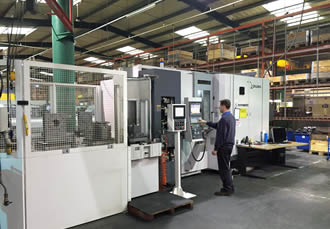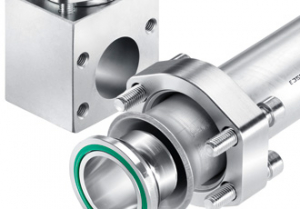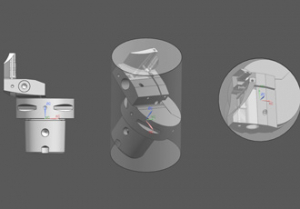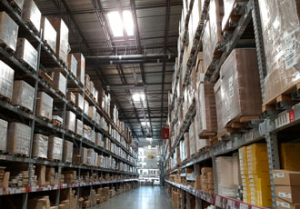Contract Machinist Gains Competitive Advantage With Okuma Turn-Cutting

Contract machinist BG Engineering operates three Japanese-built Okuma horizontal machining centres supplied by UK agent, NCMT. All are equipped for carrying out Okuma’s novel turn-cutting process, which is used extensively at the subcontractor’s facility to machine gas and steam regulator valves as well as offshore seals and gas storage equipment components.
Turn-cutting is substantially different from conventional turning operations on a machining centre, which normally involve a static turning tool in the spindle and a component rotating on a torque table. Instead, the component remains stationary on the table of an Okuma HMC while a lathe boring bar, mounted in the machining centre spindle, describes a 360-degree motion to effect the turning action.
This is achieved using circular interpolation of the X and Y axes to generate almost any size of feature up to half a metre in diameter, while feeding the tool forward in the Z axis. At the same time, the tool tip is continuously orientated by the spindle, which turns at the same rpm as the interpolated circular motion to maintain the correct rake angle.
The big advantage is that a standard boring bar for a lathe can be programmed to turn outside diameters and bores, which can be straight, tapered, stepped or profiled, as well as radiuses, chamfers, grooves and faces, eliminating the need for special tooling or attachments.
Advantages in terms of versatility and productivity are considerable, especially when dealing with low production volumes of components that are prismatic and often eccentric in shape but require turned features.
Antony Holmes, managing director of BG Engineering, explained, “Before we had turn-cutting, we used expensive boring heads of specific sizes on our HMCs to machine each of the different diameter ports in a valve body, including deep internal features.
“Separate tools were needed for corner radiusing, chamfering, grooving and face milling. Now all of these features can be produced by turn-cutting using a single boring bar with standard ceramic indexable inserts. Even the seal face can be gramophone-turned to produce a single flat spiral, avoiding the chatter associated with plunge milling.
“The cost benefits are considerable, as we do not have to buy 10 or 15 different tools when we start a new job. Bearing in mind we typically machine 1- to 10-offs and exceptionally up to 100-off, high expenditure on tooling can make a contract uneconomic.
“Additionally, cycles can be faster and more efficient if turn-cutting is employed, as the number of tool changes is drastically reduced.”
Immediately after NCMT installed the first Okuma MA600 HMC at BG Engineering in 2008, the subcontractor was able to quote zero tooling cost to a customer for a new project, as just one lathe boring bar, which was already on the shop floor, was sufficient to complete the job. The business was won as a result. Otherwise, the initial tooling would have cost £9,000 and made the first-off components prohibitively costly for the customer.
Admittedly, tooling cost per part reduces as more are produced, but the job may not involve large quantities. Moreover, a design alteration may necessitate buying further conventional tools, whereas a simple change to the turn-cutting program allows the same boring bar to produce the new features.
The initial BT50 Okuma MA600, which has a twin 630 mm pallet changer and a nominal working volume of one metre cube, was purchased to replace an ageing HMC of a different make. It was acquired when BG Engineering bought another subcontractor’s machining facility in 2006 and moved into its Chesterfield factory.
At the time, the MA600 was the second machine in the UK to have turn-cut software in the Okuma OSP control. Integral cooling of the ballscrews and nuts is included in the machine specification, as otherwise the long periods of circular interpolation at up to 300 rpm would result in thermal growth and inaccuracy.
The availability of turn-cut technology was a decisive factor in choosing the Okuma HMC, but it was not the only one. Both Mr Holmes and the subcontractor’s technical director, Shane Greveson, when they were previously employed by GKN, were impressed with the longevity and accuracy of the Japanese-built machines, which worked continuously for more than 20 years under harsh conditions. A mix of materials was processed including cast iron, which was cut dry, dust from which can accelerate wear of machine parts, especially the slideways and ballscrews.
A variety of metals is also machined at Chesterfield, ranging from aluminium to steel, stainless steels and Duplex, but most components start out as ductile iron castings. Around half of throughput is production of high- and low-pressure gas regulator valves, mostly for Honeywell, which is located in the unit adjacent to BG Engineering. Steam regulators, petrochemical seals, cryogenic gas movement equipment and 70-bar gas storage system components for offshore applications account for BG Engineering’s remaining business.
In 2012, BG Engineering purchased a second Okuma MA600 2APC machine with turn-cutting capability and a higher spindle speed of 12,000 rpm to meet increasing demand from customers and to reduce the amount of overtime being worked.
Then in 2013, a smaller 400 mm pallet machine with HSK-A63 / 15,000 rpm spindle, half-metre-cube capacity and a 10-pallet pool was installed. Designated MB4000H, the machine is also capable of turn-cutting and has taken over multiple set-up machining in low, regular volumes of components that are really too small to put on the larger machines.
Most of the components produced on all three Okumas include turn-cutting in the program, accounting for an average of 20 per cent of total cycle times over the course of a year. Even the oldest machine, dating back to 2008, is still holding 5 µm dimensional tolerance and producing 0.4 µm Ra polished surfaces on cast iron, and a 0.36 Ra finish on stainless steel, such as when producing the seal face of a cryogenic gas valve.
BG Engineering also operates two Okuma CNC turning centres, namely a Multus B400-W multitasking machine with B-axis milling head and 710 mm diameter turning capacity, installed in 2011, and an LB4000-EX MY bar-fed lathe that followed two years later. The machines are positioned opposite each other on the shop floor and are attended by one setter / operator.
In addition, NCMT has supplied a Speroni tool presetter, model STP Magis 600, that reduces non-cutting times by eliminating on-machine tool setting. It currently serves the two BT50 Okuma MA600 HMCs and the Multus lathe, which has Capto 6 tooling, but currently not the MB4000H with its HSK-63A interface.
Similar articles
More from NCMT
- 5-axis machining centres showcased at MACH 13th February 2018
- Prismatic machining, turning and grinding centres on show at MACH 13th February 2018
- Valve manufacturer adopts interpolation turning 12th January 2018
- Adhesive workholding system demonstrated at EMO 1st August 2017



ed.jpg)








Write a comment
No comments